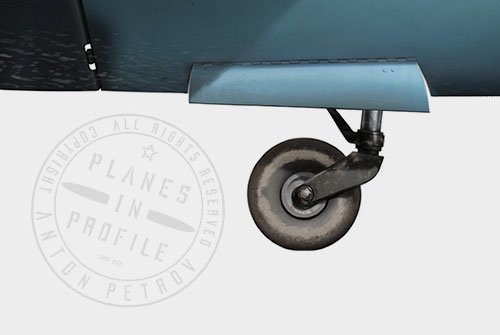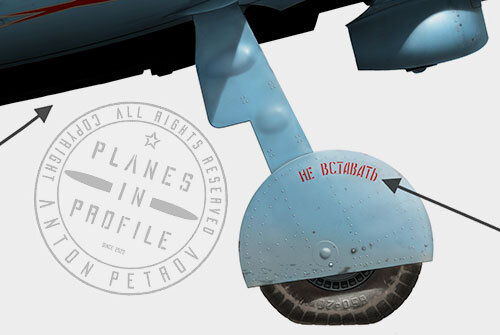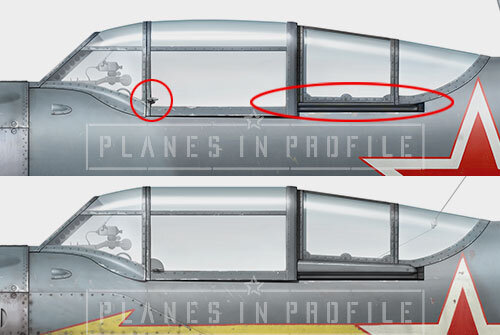“Mongolskiy Arat” White-11
Lavochkin, La-5F (Type 39)(Early)
Used by the NII VVS (Air Force Research Institute), 21st October - 31st December 1943.
(2-nd Squadron (MONGOLSKIY ARAT squadron), 2-nd GIAP, 322-nd IAD, 2-nd IAK, Bryansk Front. ) ?
‘White-11’ was possibly one of the first batch of La-5s gifted to the 2nd GIAP in September 1943. I say ‘possibly', because according to Miloš Veštšik (a researcher specialising in Lavochkin airplanes) and other sources, ‘White-11’ was used by the NII VVS (Air Force Research Institute) in the period between 21st of October and 31st of November 1943 instead. The two photos of ‘White-11’ that we have (linked below) are said to have been taken at a NII VVS airfield at around that time. The removal of the panels on the belly of the plane in one of the photos could have been part of some of the checks and tests performed by the NII VVS.
What is most interesting about White-11 is that it is branded with the ‘Mongolskiy Arat’ slogan on the fuselage. La-5s with this slogan belonged to the 2-nd squadron of the 2-nd GIAP only, for this reason the 2nd squadron was called the ‘Mongolskiy Arat’ squadron. White-11, doesn’t seem to be painted with any other markings of the 2nd squadron, adding credence to the idea that maybe it was not flown in battle by the 2nd GIAP after all, but was used by the Air Force Research Institute for various tests instead.
The "Mongolskiy Arat" squadron
On 25th of September 1943, the pilots of the 2nd GIAP were lined up for an official award ceremony on the Vyazovaya airfield in the Smolensk region. They were about to be awarded for their outstanding performance during the recent Kursk battles. Those battles created fighter aces and heroes within the ranks of the 2nd GIAP. In addition to individual pilot’s personal awards, their regiment was presented with 12 new Lavochkin La-5F airplanes, branded with bright red slogans which read ‘Mongolskiy Arat’. These planes were built with the funds collected and donated by the workers of the Mongolian People’s Republic (MPR). MPR did not only contribute the finds toward the establishment of the ‘Mongolskiy Arat’ squadron, it also funded the formation of a tank brigade called ‘Revolutionary Mongolia’, donated funds for the maintenance of their equipment, donated tens of thousands of horses, tens of thousands of other livestock, clothings items and other supplies to help the Red Army in its war effort. For this, Stalin himself wrote a letter of gratitude to the Mongolian government and people . The 2nd squadron of the 2nd GIAP was given the honour of flying the ‘Mongolskiy Arat’ planes and the 2nd squadron became known as the ‘Mongolskiy Arat’ squadron. The pilots of the 2nd GIAP in turn kept the Mongolian people informed about all the latest victories achieved by the 2nd squadron. Their stories of heroism were praised in the far-away Mongolia and many of the pilots of the 2nd GIAP went on to receive medals from the Mongolian People’s Republic for their achievements during the war [1] .
On the 25th of September 1943, The ‘Mongolskiy Arat’ squadron is described to have consisted of the following individuals:
‘The commander of the 2-nd squadron was Captain N.P. Pushkin, Hero of the Soviet Union, and Senior Lieutenant N.Ya. Zenkovich was the deputy squadron commander. The technical staff was represented by senior technicians of the guards, senior technician-lieutenant F.I. Glushchenko and guard technician-lieutenant N.I. Kononov. The flight commander was senior lieutenant G.I. Bessolitsyn, the flight technician was senior lieutenant technician N.I. Kalinin, the pilots were - guards junior lieutenants A.P. Kalinin, M.E. Ryabtsev, M.V. Baranov, and V. Davydov, A. E. Dmitrievsky, A. I. Zolotov, L. M. Masov, A. S. Subbotin, V. I. Chumak.’ [2]
The ‘Mongolskiy Arat’ fighters are said to have received their baptism of fire in the skies above Kuban, this was the location of the so-called ‘blue line’, where the Germans tried to stop the counter-attack of the Soviet forces (though by the end of September 1943 these were the closing stages of the battles in Kuban). By the end of 1943, the squadron destroyed 21 German planes [3]. The Mongolskiy Arat squadron fought on the 1st Baltic and 3rd Belorussian fronts, participating in the liberation of Belorussia, the Baltic states and Ukraine, and took part in the storming of Berlin.
More about the ‘Mongolskiy Arat’ squadron can be found on the ‘White-70’ page.
Noteworthy visual characteristics
1) The Propeller seems to be the same colour as the spinner, they both appear to be slightly darker than the AMT-11 (The lighter Grey of the camouflage) of the front of the engine cowling - they might have been painted with AMT-12 Grey, the darker grey colour of the camouflage. This colour doesn’t appear to be as dark as the star and the slogan, so it is probably not red. Note that the planes of the 2-nd squadron seem to have their spinners and sometimes some of their engine cowling painted red. ‘White-11’ does not seem to have these markings.
2) It’s hard to know if there were any technical markings on the fuselage of this plane. Based on a photo of another ‘Mongolskiy Arat’ La-5F, http://ava.org.ru/iap/2g/la5-07.jpg ,the technical markings seem to be absent. They might have either been absent or painted a darker colour, such as red or possibly yellow, which blends with the greys in the black and white photos.
3) The tail star seems to be the same size as the fuselage star, which is non-standard.
4) The tail wheel mechanism was probably painted black since it appears to be quite dark in the photo reference. The wheel disk might have been grey.
5) The slogan ‘Mongolskiy Arat’ translates to ‘Mongolian peasant/worker’, it’s the slogan that appeared on the planes of the 2-nd fighter squadron of the 2-nd GIAP. These planes were built with the funds collected by the Mongolian People’s Republic. The slogan is written diagonally across the fuselage, which was consistent with the airplanes in the first batch gifted by the M.P.R.. The following batches of planes had the slogan written horizontally, under the canopy, as per White-70.
6) Note the differences in the canopy of ‘White-11’ and the standard canopy of the La-5F/FNs. More on this in the close-up below
7) In the photo reference It looks like the panels on the belly of the plane have been removed, exposing some of the interior structure. In my artwork I have drawn the right side of the plane as per the photo reference (with the belly of the plane removed), and the left side with all the panels back in place.
8) The cowl bands were probably painted over, with the paint chipped off in many places.
9) The ‘F’ logo representing the ‘F’ type La-5 is absent in the photo reference. it usually appears in the area indicated by the arrow, as well as on the top of the tail.
10) The warning on the wheel shields is hard to make out, but it looks like it reads ‘Не Вставать’ which loosely translates to ‘Don’t get up (on top of) ’, as opposed to the usual ‘Не Становиться’ which loosely translates to ‘Don’t stand on’.
11) Based on the photo reference, the camouflage pattern on the wings doesn't seem to follow the standard Grey/Grey NKAP camo pattern regulations introduced in July 1943. It seems to be more consistent with the Green/Black camo pattern of 1941. There is a possibility that this plane might have actually been repainted from a Green-Black camo to the Grey-Grey camo on the fuselage only and not on the wings, though it doesn’t seem likely because then one would expect the (factory applied?) inscription to have been painted over also, and it doesn’t look like it was painted over. It is also possible that the wings might have been repainted in two shades of Grey, but the actual camo pattern remained being similar to the one from 1941.
12) On Patreon
Here are a few close-up images to help illustrate the points above. Full set of close-up images is On Patreon
FOOTNOTES
[1] most of this info is taken from the following book :
Семенов А.Ф., Дашцэрэн Б. Эскадрилья 'Монгольский арат'. — М., Воениздат, 1971. The Russian version of this text can be accessed here: http://militera.lib.ru/h/semenov2/index.html
[2] This info is taken from the article linked here https://tatamo.livejournal.com/5546559.html?fbclid=IwAR0RuHwkGoaj4J9JJ55Bzv3Pq3zDqimtVQ3tbpbFgyRbzt-8gLyRQB7ujFc
But it appears in many other sources, including in the book mentioned in a footnote number [1]
[3] Info taken from https://legendtour.ru/rus/mongolia/history/mongolian_arat.shtml?fbclid=IwAR0DdDZgzFt03IG3l-9tiVSr2MQTOHYIQMzS1fH7nSR6O0uHneWMu9FarVY
All the work presented on this is page is subject to updates and revisions in the light of new information which might present itself. If you have any new information relevant to this page or disagree with anything that's presented here, then please feel free to contact me through the Planes in Profile Facebook page. Thanks:)





